资料分享初中英语之2个常见介词用法
- 格式:doc
- 大小:502.50 KB
- 文档页数:14
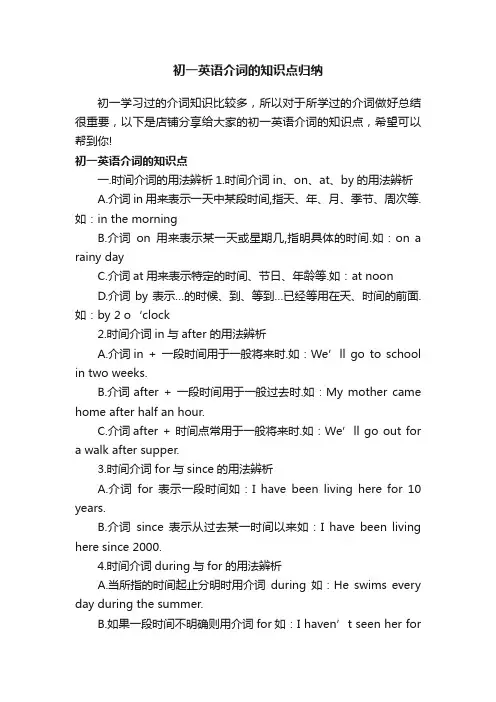
初一英语介词的知识点归纳初一学习过的介词知识比较多,所以对于所学过的介词做好总结很重要,以下是店铺分享给大家的初一英语介词的知识点,希望可以帮到你!初一英语介词的知识点一.时间介词的用法辨析1.时间介词in、on、at、by的用法辨析A.介词in用来表示一天中某段时间,指天、年、月、季节、周次等.如:in the morningB.介词on用来表示某一天或星期几,指明具体的时间.如:on a rainy dayC.介词at用来表示特定的时间、节日、年龄等.如:at noonD.介词by表示…的时候、到、等到…已经等用在天、时间的前面.如:by 2 o‘clock2.时间介词in与after 的用法辨析A.介词in + 一段时间用于一般将来时.如:We’ll go to school in two weeks.B.介词after + 一段时间用于一般过去时.如:My mother came home after half an hour.C.介词after + 时间点常用于一般将来时.如:We’ll go out fora walk after supper.3.时间介词for与since的用法辨析A.介词for 表示一段时间如:I have been living here for 10 years.B.介词since 表示从过去某一时间以来如:I have been living here since 2000.4.时间介词during与for的用法辨析A.当所指的时间起止分明时用介词during如:He swims every day during the summer.B.如果一段时间不明确则用介词for如:I haven’t seen her foryears.5.时间介词before与by的用法辨析A.介词before表示“在…之前”如:He won’t come back before five .B.介词by表示“到…时为止,不迟于…”如:The work must be finished by Friday.6.时间介词till与until用法的异同A.till和until用在肯定句中,均可表示“直到…为止”,如:I will wait till(until)seven o'clock.B.till和until用在否定句中,均可表示“在…以前”或“直到…才”.如:Tom didn't come back till(until)midnight.C.till多用于普通文体,而 until则用于多种文体,并且在句子开头时,用until而不用till.如:Until he comes back,nothing can be done.7.不用介词表达时间的几种情况A.当表示时间的词前有this, that时,其前面不用介词,如:this morningB.当表示时间的词前有next时,其前面不用介词,如:next SundayC.当表示时间的词前有last时,其前面不用介词,如:last SundayD.当表示时间的词前有one, any, each, every, some或all时,其前面不用介词,如:You can come any day.二.方位介词与地点介词的用法辨析1.方位介词on, over, above的用法辨析A.介词on表示一物放在另一物上面,两者紧贴在一起,如:The book is on the table.B.介词over表示一种垂直悬空的上下关系,即“在…上方”,如:Is there any bridge over the river?C.介词above表示一般的“高于…”,“在…之上”,如:There was an electric clock above his bed.2.方位介词under与below的用法辨析A.介词under是over的反义词即“在…下方”,如:They were seen under the tree.B.介词below是above的反义词即“低于…”,“在…之下”,如:They live below us.3.方位介词across,、through、over,、past的用法辨析A.介词across着重于“从一头或一边到另一头或另一边”,强调从表面穿过.如:She went across the street to make some purchases.B.介词through着重于“穿越”,强调从一定的空间内穿过.如:The sunlight was coming in through the window.C.介词over多表示从“上方越过”,如:He failed to go over the mountain; he had to go round it.D.介词past表示从“面前经过”,如:Someone has just gone past the window.4.方位介词in、on、at的用法辨析A.介词in表示“排、行、组”,如:We are in Team One.B.介词on表示“左、右”,如:Li Ping is on my left.C.介词at表示“前、后”,如:I sit at the front of the classroom.5.方位介词to、for的用法辨析A.介词to表示目的地或去的目的,如:Wil you take a train to Tianjian.B.介词for表示动身去某地,如:He got on a train for Shanghai.6.地点介词at与in的用法辨析A.介词at表示较小的地方,如家、村、乡村等,如:He lives at a small village.B.介词in表示较大的地方,如大城市、国家、洲等,如:He lives in Beijing.7.地点介词at与on的用法辨析A.介词at用于门牌号,如:He lives at No.200, Nanjing Road.B.介词on用于路名,如:He lives on Nanjing Road.8.地点介词in、on、to的用法辨析A.介词in表示“包含”如:Beijing is in the north of China.B.介词on表示“紧邻”如:Canada lies on the north of the U.S.C.介词to表示“没接触”如:France lies to the south of England.初一学好英语的建议一、培育学习英语的兴致爱因斯坦以前说过:“兴致和喜好是最好的老师。
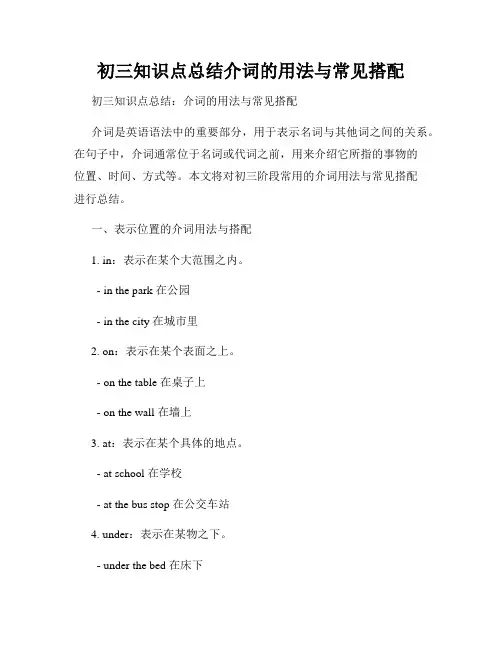
初三知识点总结介词的用法与常见搭配初三知识点总结:介词的用法与常见搭配介词是英语语法中的重要部分,用于表示名词与其他词之间的关系。
在句子中,介词通常位于名词或代词之前,用来介绍它所指的事物的位置、时间、方式等。
本文将对初三阶段常用的介词用法与常见搭配进行总结。
一、表示位置的介词用法与搭配1. in:表示在某个大范围之内。
- in the park 在公园- in the city 在城市里2. on:表示在某个表面之上。
- on the table 在桌子上- on the wall 在墙上3. at:表示在某个具体的地点。
- at school 在学校- at the bus stop 在公交车站4. under:表示在某物之下。
- under the bed 在床下- under the tree 在树下5. by:表示在某物的旁边。
- by the river 在河边- by my side 在我身边二、表示时间的介词用法与搭配1. at:表示在某个具体的时间点。
- at 7 o'clock 在7点钟- at midnight 在午夜2. on:表示在某个具体的日期或星期。
- on Monday 在星期一- on Christmas Day 在圣诞节3. in:表示在某个时间段内。
- in the morning 在早晨- in the summer 在夏季4. during:表示在某个时间段内的一段时间。
- during the holidays 在假期期间- during the meeting 在会议期间三、表示方式的介词用法与搭配1. with:表示使用某种工具或手段。
- write with a pen 用钢笔写- open with a key 用钥匙开启2. by:表示通过某种方式或方法。
- travel by plane 乘飞机旅行- learn by doing 通过实践学习3. in:表示以某种方式或状态。
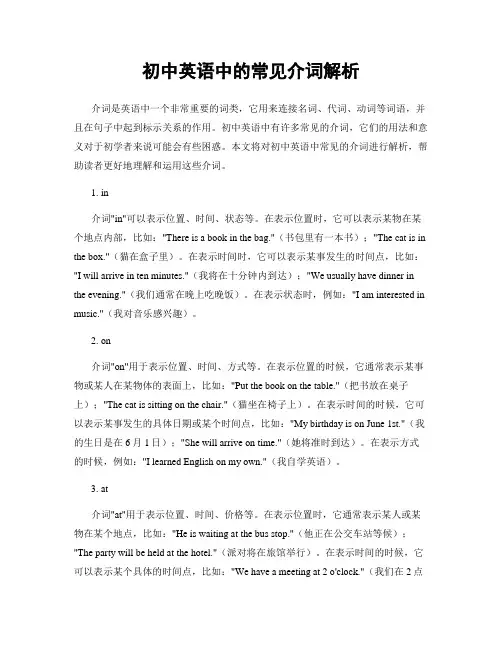
初中英语中的常见介词解析介词是英语中一个非常重要的词类,它用来连接名词、代词、动词等词语,并且在句子中起到标示关系的作用。
初中英语中有许多常见的介词,它们的用法和意义对于初学者来说可能会有些困惑。
本文将对初中英语中常见的介词进行解析,帮助读者更好地理解和运用这些介词。
1. in介词"in"可以表示位置、时间、状态等。
在表示位置时,它可以表示某物在某个地点内部,比如:"There is a book in the bag."(书包里有一本书);"The cat is in the box."(猫在盒子里)。
在表示时间时,它可以表示某事发生的时间点,比如:"I will arrive in ten minutes."(我将在十分钟内到达);"We usually have dinner in the evening."(我们通常在晚上吃晚饭)。
在表示状态时,例如:"I am interested in music."(我对音乐感兴趣)。
2. on介词"on"用于表示位置、时间、方式等。
在表示位置的时候,它通常表示某事物或某人在某物体的表面上,比如:"Put the book on the table."(把书放在桌子上);"The cat is sitting on the chair."(猫坐在椅子上)。
在表示时间的时候,它可以表示某事发生的具体日期或某个时间点,比如:"My birthday is on June 1st."(我的生日是在6月1日);"She will arrive on time."(她将准时到达)。
在表示方式的时候,例如:"I learned English on my own."(我自学英语)。

初中英语知识点归纳介词的用法介词是连接词与词之间,短语与短语之间,在句中表示方向、关系、时间、原因等意义的词语。
在英语中,介词的用法非常丰富多样,掌握好介词的用法,对于学习英语有着重要的意义。
下面将对初中英语中常见的介词用法进行归纳介绍。
一、表示方向、位置和距离的介词1. 在(in):在某个地方或物体内部2. 在(on):在某个平面或表面上3. 在(at):在某个地点4. 在(over):位于之上,不接触5. 在(under):位于之下,不接触6. 在(between):在两个事物之间7. 在(behind):在某物之后8. 在(in front of):在某物之前9. 在(near):在附近10. 在(around):在周围二、表示时间的介词1. 在(at):在某个具体时间点2. 在(in):在某个时间段3. 在(on):在某个具体日期三、表示原因的介词1. 因为(of):表示原因、缘故2. 由于(because of):表示原因、由于四、表示目的、用途和方式的介词1. 为了(in order to):表示目的2. 以便(in order that):表示目的3. 用(with):表示使用的手段或工具4. 通过(by):表示方式、方法5. 以(for):表示目的五、表示比较的介词1. 比较起见(than):表示比较的对象2. 和(with):与某人或某物在一起六、其它常见的介词1. 关于(about):表示涉及某一话题2. 靠(by):表示接近某人或某物3. 经过(through):表示通过某地或某事4. 编写(at):表示在某地工作或活动5. 因(as):表示角色、身份6. 例如(for example):表示举例7. 包括(including):表示包含某物以上是初中英语中常见的介词用法的归纳总结。
熟练掌握这些介词的用法,对于构建正确的句子和语法结构非常重要。
希望能对你的学习有所帮助。
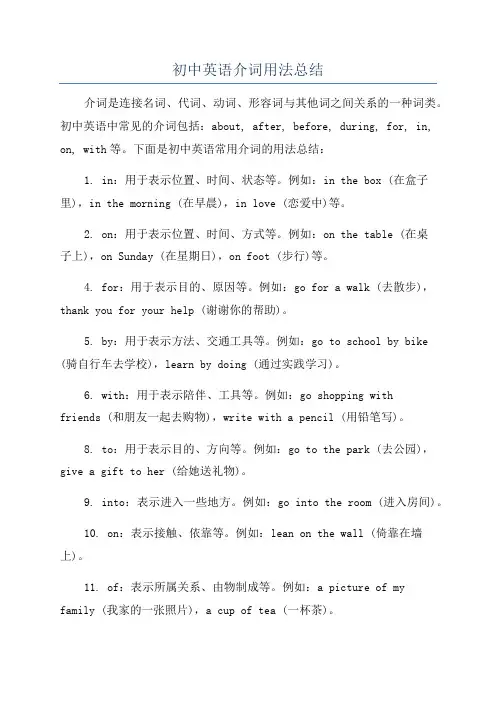
初中英语介词用法总结介词是连接名词、代词、动词、形容词与其他词之间关系的一种词类。
初中英语中常见的介词包括:about, after, before, during, for, in, on, with等。
下面是初中英语常用介词的用法总结:1. in:用于表示位置、时间、状态等。
例如:in the box (在盒子里),in the morning (在早晨),in love (恋爱中)等。
2. on:用于表示位置、时间、方式等。
例如:on the table (在桌子上),on Sunday (在星期日),on foot (步行)等。
4. for:用于表示目的、原因等。
例如:go for a walk (去散步),thank you for your help (谢谢你的帮助)。
5. by:用于表示方法、交通工具等。
例如:go to school by bike (骑自行车去学校),learn by doing (通过实践学习)。
6. with:用于表示陪伴、工具等。
例如:go shopping withfriends (和朋友一起去购物),write with a pencil (用铅笔写)。
8. to:用于表示目的、方向等。
例如:go to the park (去公园),give a gift to her (给她送礼物)。
9. into:表示进入一些地方。
例如:go into the room (进入房间)。
10. on:表示接触、依靠等。
例如:lean on the wall (倚靠在墙上)。
11. of:表示所属关系、由物制成等。
例如:a picture of myfamily (我家的一张照片),a cup of tea (一杯茶)。
12. with:表示伴随、具有。
例如:a girl with long hair (一个长发的女孩),a book with pictures (一本有图片的书)。
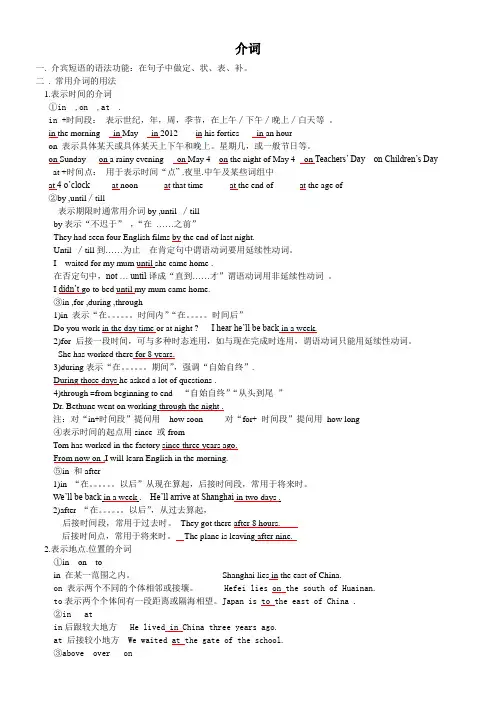
介词一. 介宾短语的语法功能:在句子中做定、状、表、补。
二. 常用介词的用法1.表示时间的介词①in ,on ,at .in +时间段:表示世纪,年,周,季节,在上午∕下午∕晚上∕白天等。
in the morning in May in 2012 in his forties in an houron 表示具体某天或具体某天上下午和晚上。
星期几,或一般节日等。
on Sunday on a rainy evening on May 4 on the night of May 4 on Teachers’ Day on Children’s Day at +时间点:用于表示时间“点” .夜里.中午及某些词组中at 4 o’clock at noon at that time at the end of at the age of②by ,until∕till表示期限时通常用介词by ,until ∕tillby表示“不迟于”,“在……之前”They had seen four English films by the end of last night.Until ∕till到……为止在肯定句中谓语动词要用延续性动词。
I waited for my mum until she came home .在否定句中,not … until译成“直到……才”谓语动词用非延续性动词。
I didn’t go to bed until my mum came home.③in ,for ,during ,through1)in 表示“在。
时间内”“在。
时间后”Do you work in the day time or at night ? I hear he’ll be back in a week.2)for 后接一段时间,可与多种时态连用,如与现在完成时连用,谓语动词只能用延续性动词。
She has worked there for 8 years.3)during表示“在。
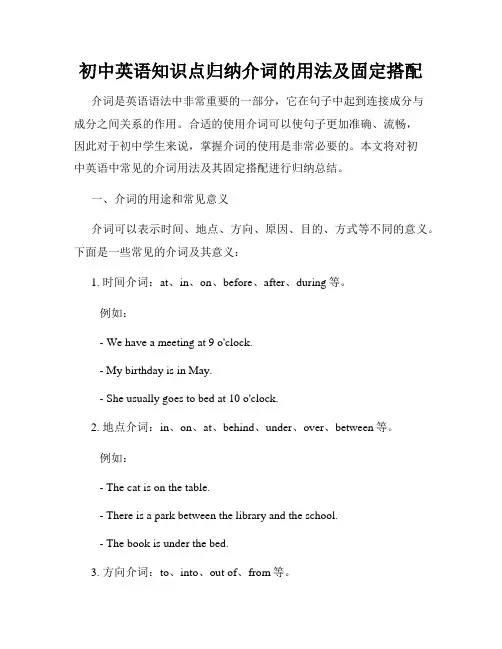
初中英语知识点归纳介词的用法及固定搭配介词是英语语法中非常重要的一部分,它在句子中起到连接成分与成分之间关系的作用。
合适的使用介词可以使句子更加准确、流畅,因此对于初中学生来说,掌握介词的使用是非常必要的。
本文将对初中英语中常见的介词用法及其固定搭配进行归纳总结。
一、介词的用途和常见意义介词可以表示时间、地点、方向、原因、目的、方式等不同的意义。
下面是一些常见的介词及其意义:1. 时间介词:at、in、on、before、after、during等。
例如:- We have a meeting at 9 o'clock.- My birthday is in May.- She usually goes to bed at 10 o'clock.2. 地点介词:in、on、at、behind、under、over、between等。
例如:- The cat is on the table.- There is a park between the library and the school.- The book is under the bed.3. 方向介词:to、into、out of、from等。
例如:- She walked into the room.- The bird flew out of the cage.- He ran from the dog.4. 原因介词:because of、due to等。
例如:- He couldn't come to the party because of the bad weather. - The delay was due to the traffic jam.5. 目的介词:for、to等。
例如:- I bought a new dress for the party.- We need to study hard to pass the exam.6. 方式介词:by、with等。
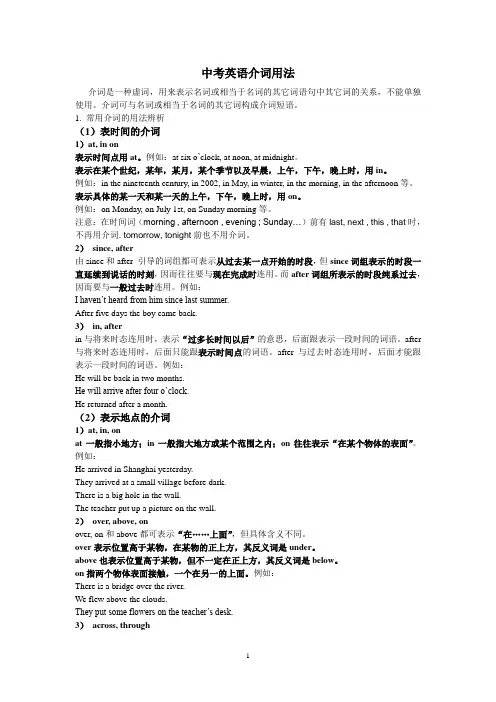
中考英语介词用法介词是一种虚词,用来表示名词或相当于名词的其它词语句中其它词的关系,不能单独使用。
介词可与名词或相当于名词的其它词构成介词短语。
1. 常用介词的用法辨析(1)表时间的介词1)at, in on表示时间点用at。
例如:at six o’clock, at noon, at midnight。
表示在某个世纪,某年,某月,某个季节以及早晨,上午,下午,晚上时,用in。
例如:in the nineteenth century, in 2002, in May, in winter, in the morning, in the afternoon等。
表示具体的某一天和某一天的上午,下午,晚上时,用on。
例如:on Monday, on July 1st, on Sunday morning等。
注意:在时间词(morning , afternoon , evening ; Sunday…)前有last, next , this , that时,不再用介词. tomorrow, tonight前也不用介词。
2)since, after由since和after 引导的词组都可表示从过去某一点开始的时段,但since词组表示的时段一直延续到说话的时刻,因而往往要与现在完成时连用。
而after词组所表示的时段纯系过去,因而要与一般过去时连用。
例如:I haven’t heard from him since last summer.After five days the boy came back.3)in, afterin与将来时态连用时,表示“过多长时间以后”的意思,后面跟表示一段时间的词语。
after 与将来时态连用时,后面只能跟表示时间点的词语。
after与过去时态连用时,后面才能跟表示一段时间的词语。
例如:He will be back in two months.He will arrive after four o’clock.He returned after a month.(2)表示地点的介词1)at, in, onat一般指小地方;in一般指大地方或某个范围之内;on往往表示“在某个物体的表面”。
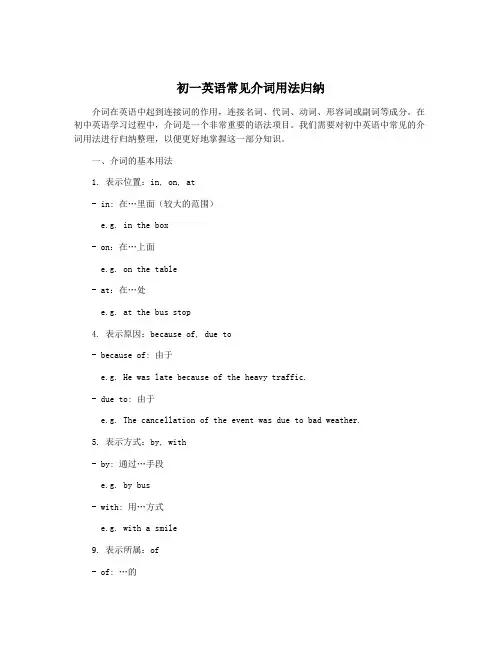
初一英语常见介词用法归纳介词在英语中起到连接词的作用,连接名词、代词、动词、形容词或副词等成分。
在初中英语学习过程中,介词是一个非常重要的语法项目。
我们需要对初中英语中常见的介词用法进行归纳整理,以便更好地掌握这一部分知识。
一、介词的基本用法1. 表示位置:in, on, at- in: 在…里面(较大的范围)e.g. in the box- on:在…上面e.g. on the table- at:在…处e.g. at the bus stop4. 表示原因:because of, due to- because of: 由于e.g. He was late because of the heavy traffic.- due to: 由于e.g. The cancellation of the event was due to bad weather.5. 表示方式:by, with- by: 通过…手段e.g. by bus- with: 用…方式e.g. with a smile9. 表示所属:of- of: …的e.g. the hat of the boy2. look forward to: 期待e.g. I am looking forward to the summer vacation.5. be interested in: 对…感兴趣e.g. Amy is interested in learning Chinese.三、常见介词错误用法及纠正1. 错误用法:depend of正确用法:depend one.g. We depend on each other.通过以上的介词错误用法及纠正,我们可以更清晰地了解该如何正确使用这些介词。
四、综合练习通过上述的综合练习,可以帮助大家更好地掌握介词用法。
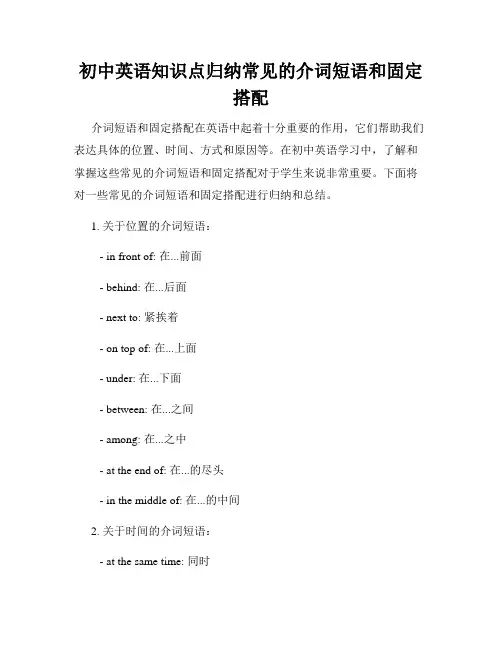
初中英语知识点归纳常见的介词短语和固定搭配介词短语和固定搭配在英语中起着十分重要的作用,它们帮助我们表达具体的位置、时间、方式和原因等。
在初中英语学习中,了解和掌握这些常见的介词短语和固定搭配对于学生来说非常重要。
下面将对一些常见的介词短语和固定搭配进行归纳和总结。
1. 关于位置的介词短语:- in front of: 在...前面- behind: 在...后面- next to: 紧挨着- on top of: 在...上面- under: 在...下面- between: 在...之间- among: 在...之中- at the end of: 在...的尽头- in the middle of: 在...的中间2. 关于时间的介词短语:- at the same time: 同时- on time: 准时- in the morning/afternoon/evening: 在早晨/下午/晚上 - at night: 在晚上- on Monday/Tuesday, etc.: 在星期一/星期二...- in January/February, etc.: 在一月/二月...- during the summer/winter: 在夏天/冬天期间3. 表示方式的介词短语:- by air/train/bus: 乘飞机/火车/公共汽车- on foot: 步行- in a hurry: 匆忙地- with the help of: 在...的帮助下- in a loud/soft voice: 以大声/轻声地4. 常见的介词固定搭配:- interested in: 对...感兴趣- good at: 擅长于- excited about: 对...感到兴奋- proud of: 为...感到自豪- worried about: 担心...- depend on: 依赖...- get along with: 与...相处- look forward to: 期待...- think of: 想到...以上仅是部分常见的介词短语和固定搭配,掌握这些基本用法有助于学生更好地理解和运用英语。
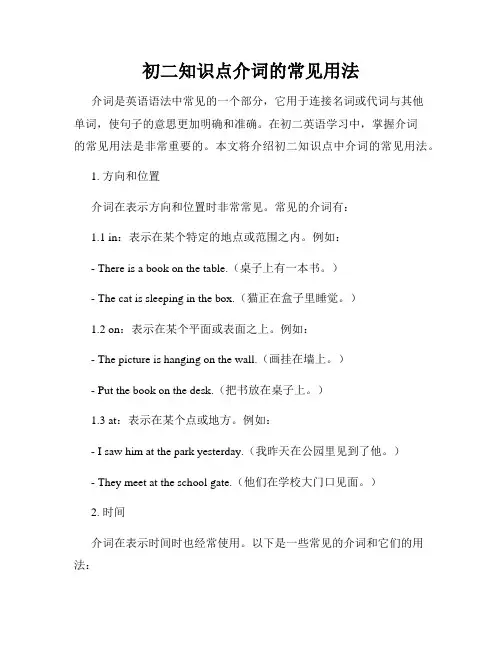
初二知识点介词的常见用法介词是英语语法中常见的一个部分,它用于连接名词或代词与其他单词,使句子的意思更加明确和准确。
在初二英语学习中,掌握介词的常见用法是非常重要的。
本文将介绍初二知识点中介词的常见用法。
1. 方向和位置介词在表示方向和位置时非常常见。
常见的介词有:1.1 in:表示在某个特定的地点或范围之内。
例如:- There is a book on the table.(桌子上有一本书。
)- The cat is sleeping in the box.(猫正在盒子里睡觉。
)1.2 on:表示在某个平面或表面之上。
例如:- The picture is hanging on the wall.(画挂在墙上。
)- Put the book on the desk.(把书放在桌子上。
)1.3 at:表示在某个点或地方。
例如:- I saw him at the park yesterday.(我昨天在公园里见到了他。
)- They meet at the school gate.(他们在学校大门口见面。
)2. 时间介词在表示时间时也经常使用。
以下是一些常见的介词和它们的用法:2.1 at:表示具体的时间点。
例如:- The party is at 7 o'clock.(晚会在7点举行。
)- We have English class at 9:30 every morning.(我们每天早上9点半上英语课。
)2.2 on:表示具体的日期或星期。
例如:- We have a meeting on Monday.(我们星期一开会。
)- His birthday is on September 10th.(他的生日是9月10日。
)2.3 in:表示一个较长的时间段。
例如:- I will go on vacation in July.(我将在七月份去度假。
)- We have a holiday in winter.(我们在冬季放假。
初中英语知识点归纳介词短语的常见搭配与用法初中英语知识点归纳:介词短语的常见搭配与用法介词短语在英语中是非常常见且重要的语法结构之一。
掌握了介词短语的常见搭配与用法,对于学习和运用英语语言来说至关重要。
本文将归纳介绍初中英语中常见的介词短语搭配及其用法。
一、关于地点的介词短语1. in front of - 在...前面例句:The school is located in front of the park.2. at the top/bottom of - 在...的顶部/底部例句:The book you are looking for is at the top of the shelf.3. on the left/right - 在...的左边/右边例句:She lives in the house on the left.4. next to - 紧挨着,旁边例句:There is a café next to the library.5. in the middle of - 在...的中间例句:The monument stands in the middle of the park.二、关于时间的介词短语1. at (a specific time) - 在(特定时间)例句:I will meet you at 3 o'clock.2. in (a month/year/season) - 在(某个月份/年份/季节)例句:My birthday is in December.3. on (a specific day/date) - 在(特定日子/日期)例句:We usually have a family gathering on Christmas Day.4. during (a period of time) - 在(某段时间)例句:I traveled to Europe during the summer vacation.5. from...to - 从...到...例句:The museum is open from 9 a.m. to 5 p.m.三、关于方式的介词短语1. by car/bus/bike - 通过汽车/公交车/自行车例句:I usually go to work by bike.2. on foot - 步行例句:He goes to school on foot every day.3. with the help of - 在...的帮助下例句:He completed the project with the help of his teammates.4. in a hurry - 匆忙地例句:I left the house in a hurry and forgot to bring my phone.5. by myself/ourselves - 自己例句:I finished the homework by myself.四、关于目的的介词短语1. for (a purpose) - 为了(某个目的)例句:She is studying hard for the exam.2. to (a place) - 去(某个地方)例句:I am going to the supermarket to buy some groceries.3. in order to - 为了例句:He saved money in order to buy a new car.4. with the aim of - 以...为目标例句:They started the project with the aim of promoting environmental awareness.五、关于原因的介词短语1. because of - 因为例句:The match was canceled because of the heavy rain.2. due to - 因为例句:The flight was delayed due to bad weather conditions. 3. as a result of - 由于例句:As a result of his hard work, he obtained excellent results.4. thanks to - 多亏了例句:Thanks to your help, I finished the task on time.六、关于状态的介词短语1. in good/bad condition - 状况良好/不好例句:The car is in good condition after the repair.2. with the help of - 在...的帮助下例句:He fixed the broken computer with the help of his friend.3. under pressure - 在压力下例句:She always performs well under pressure.4. by accident - 偶然地例句:I found this book by accident while cleaning the attic.七、关于数量的介词短语1. a couple of - 两个,几个例句:I bought a couple of books from the bookstore.2. a few - 几个,少量例句:I have a few friends who live in this city.3. a lot of - 许多例句:There are a lot of people in the park today.4. plenty of - 充足的例句:There is plenty of food at the party, so don't worry.以上是初中英语中常见的介词短语搭配及其用法的归纳。
初中英语语法——介词(常考)考点1 时间介词①in,after,later表示时间的区别in +时间段,用于将来时,表示“过……后”。
He will come back in an hour.after+一段时间,用于过去时,表示“在……以后”。
After an hour,he came back.after+时间点,用于将来时,表示“在……以后”。
He will come back after 5 o'clock.时间段+later,常用于过去时,表示“在……之后”。
An hour later,he came back.②in,on,at表示时间的区别in 主要表达年、月、季节、年代、世纪;泛指上午、下午、晚上。
➢in spring在春天in February在二月in the 21st century在21世纪➢We have four lessons in the morning. 我们上午有四节课。
on 主要表示星期、日期或具体的某一天;特指具体某一天的上午、下午、晚上用on。
➢on Monday在星期一on May 1st在五月一号on Labor Day在劳动节➢We have two lessons on Friday afternoon. 我们周五下午有两节课。
at 表示某一时刻,用于具体时间点前,或正午和午夜前。
➢at 7:00在七点at noon 在正午at night在晚上/在午夜➢We start classes at eight o’clock every morning. (注意every, this, last, next前不加介词)我们每天早上八点上课。
③for,since 表示时间的区别(现在完成时的标志词)for +时间段➢I have lived here for 10 years. 我已经住在这里十年了。
since +时间点/ago短语/一般过去时的从句➢I have lived here since 2013.自从2013年我就住在这里。
初中英语语法----介词介词只能用在一个名词、代词或相当于名词的结构之前,也可以与后面的词一起构成介词短语。
介词通常位于名词或代词之前。
常见的介词用法:一.on1.表地点“在------上面”There is a book on the desk.桌子上有一本书。
2.表时间:①表示“在具体某一天(的上午、下午或晚上)”(具体到“天”)②表示“在星期几(的上午、下午或晚上)”on Monday在星期一on Monday morning在星期一的早上on January fifth 在1月5日on the afternoon of May 1 在五月一日的下午二.in1.表方位“在------里面”There is a pen in the pencil-box.铅笔盒里有一支钢笔。
2表地点:②表示“在大地方”②表示“在…范围内”(属于该范围)。
I live in Beijing. 我住在北京。
Jiangsu lies in the east of China. 江苏在中国的东部。
3.表时间:①表示“在较长时间,如年、季节、月等”(不具体到“天”)②表示“在------(早上、下午、晚上)”in 2015 在2015年in April 在四月in the morning/afternoon/evening 在早上/下午/晚上4.使用某种语言、材料等。
They speak to us in English.他们用英语和我们讲话。
Please write in ink. 请用钢笔写。
三.at四.表方位的介词(短语)1.in表示“在…… 里面”There is a pen in the pencil-box.铅笔盒里有一支钢笔。
2.on表示“在……上面”(与物体表面接触)There is a book on the desk.桌子上有一本书。
3.over表示“在……上面”(位于正上方,与物体表面不接触)There is a bridge over the river.河上有一座桥。
初中英语介词的用法一、介词按其构成可分为:1. 简单介词at, in, on, to, since, until 等。
如:He's worked there since 1998.2. 复合介词into, onto, out of 等。
如:She is out of school. 她毕业了。
3. 二重介词from under, from behind, from out of, until after, except in 等。
如:I'm from out of town. 我是从城外来的。
4. 短语介词because of, instead of, in spite of 等。
如:I went back not because of the rain, but because I was tired.我回去不是因为下雨,而是因为我累了。
二、介词的作用:1. 表示地点:after, along, at, below, by, of, near, over, through, under 等。
如:Near the village the boys are skating on the ice. 男孩子们正在村子附近的冰上滑冰。
They lay down under the shade of a tree. 他们躺在一棵树的树阴下。
2. 表示时间:about, after, across, at, during, for, in, of, till, until 等。
如:After class he will tell us about the accident. 课后他将告诉我们有关事故的情况。
A heavy rain has been falling across three days. 一场大雨下了整整三天。
The accident happened during the night. 事故发生在夜间。
表示方位的介词:in, to, on1. in 表示在某地范围之内。
如:Shanghai is/lies in the east of China.上海在中国的东部。
2. to 表示在某地范围之外。
如:Japan is/lies to the east of China.日本位于中国的东面。
3. on 表示与某地相邻或接壤。
如:Mongolia is/lies on the north of China.蒙古国位于中国北边。
表示计量的介词:at, for, by1. at表示“以……速度”“以……价格”如:It flies at about 900 kilometers a hour.它以每小时900公里的速度飞行。
I sold my car at a high price.我以高价出售了我的汽车。
2. for表示“用……交换,以……为代价”如:He sold his car for 500 dollars.他以五百元把车卖了。
注意:at表示单价(price) ,for表示总钱数。
3. by表示“以……计”,后跟度量单位如:They paid him by the month.他们按月给他计酬。
Here eggs are sold by weight.在这里鸡蛋是按重量卖的。
表示材料的介词:of, from, in1. of成品仍可看出原料如:This box is made of paper.这个盒子是纸做的。
2. from成品已看不出原料如:Wine is made from grapes.葡萄酒是葡萄酿成的。
3. in 表示用某种材料或语言如:Please fill in the form in pencil first.请先用铅笔填写这个表格。
They talk in English.他们用英语交谈。
注意:in指用材料,不用冠词;而with指用工具,要用冠词。
如:draw in pencil/draw with a pencil表示工具或手段的介词:by, with, on1、by用某种方式,多用于交通如by bus乘公共汽车,by e-mail. 通过电子邮件。
初三知识点总结介词用法初三知识点总结:介词用法介词是英语语法中的一部分,用于连接名词、代词、动词或其他词类,以表示关系、位置、方向、时间等。
本文将对初三学生常见的介词用法进行总结。
1. 介词的基本用法介词通常位于名词或代词之前,表示其与其他句子成分的关系。
常见的介词包括:in、on、at、over、under、beside等。
例如:- We live in a small town.- Please put the book on the table.- I met him at the park.2. 表示位置和方向的介词介词常用于描述物体的位置和方向。
例如:- The cat is under the table.- He ran towards the school.- The ball rolled into the garden.3. 表示时间的介词介词也常用于表示时间,如:- I usually go shopping on Sundays.- We will have a party in the evening.- She stayed at home during the holidays.4. 表示方式、原因和目的的介词介词还可以表示方式、原因和目的。
例如:- She passed the exam with hard work.- He studied English for his future career.- We watched the movie for entertainment.5. 介词短语介词短语是由介词及其后面的宾语组成的短语。
介词短语可以用来修饰名词或者动词的。
例如:- The key to success is hard work. (修饰名词)- She is good at playing the piano. (修饰动词)6. 习惯用法有些动词或短语固定搭配特定的介词,习惯用法需要记住。